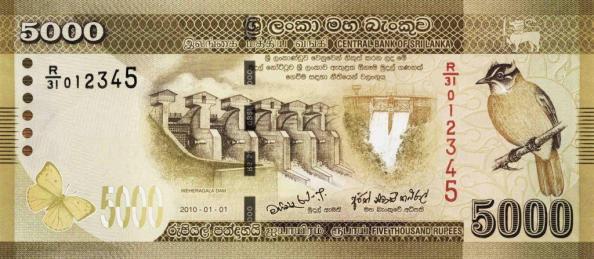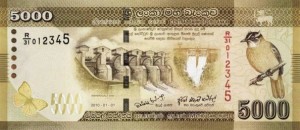Sri Lanka’s central bank has sterilized a foreign exchange sale injecting 8.0 billion rupees in one-month money into the banking system, ending several weeks of monetary policy that has been favourable of a stronger exchange rate.
On Friday the central bank printed 8.0 billion rupees for one month at 9.81 percent, slightly above the 9.75 percent reverse repo rate at which overnight liquidity is injected into the banking system for 31 days.
Until Thursday the monetary authority was injecting cash overnight in to the banking system, following a large liquidity shortage that occurred in late September. In a pegged exchange rate system, a large liquidity shortage occurs through an unsterilized foreign exchange sale.
While overnight rupee injections also generate demand in the economy, it can be less damaging than longer term cash injections, since bank managers will not try to grow the loan book while funding the balance sheet with overnight liquidity.
Instead they will try to cover the positions by curbing loan growth or raising more deposits or both.
But central bank liquidity injections through term Treasury bill purchases allow banks to focus on loans again, preventing the adjustment of the economy to the outflow of money through the central bank foreign exchange sales and triggering balance of payments trouble.
Analysts say in Sri Lanka it is state banks, which provide credit to loss making state energy enterprises or fund the state cash shortages were most likely run short of rupee reserves in previous balance of payments crises episodes.
Unsterilized foreign exchange sales (especially when banks are forced to run short reserves instead of being given overnight liquidity) do not result in any weakness in the foreign exchange peg.
Hard pegs or currency boards, make unsterilized forex transactions since the monetary authority cannot legally print money either to finance a state deficit budget or to sterilize foreign exchange sales.
Sterilized foreign exchange sales are a feature of so-called ‘soft-pegs’ which were built under US advice shortly after the Second World War under the failed Bretton Woods system leading to currency collapse around the world including in Sri Lanka.
LBO’s economics columnist fuss-budget says soft-pegs were pushed by American interventionists including Harry Dexter White, a US Treasury official who was the architect of the both the Bretton Woods system and the International Monetary Fund which was created to rescue pegs that ran into trouble.
Dexter White, who headed the Office of Monetary Research of the US Treasury was later suspected to be a communist agent named as ‘Jurist’ in Soviet communications following a probe by the ‘Venona’ cryptography project of the American intelligence services.
Sterilized foreign exchange sales, as well as the ability of newly created central banks to monetize debt – especially in former British colonial territories – triggered balance of payments crises and impoverished entire populations with high inflation and currency depreciation in the post war years.
The US itself fell prey to the sterilized foreign exchange sales in 1971-73 leading to the collapse of the Bretton Woods and the gold peg to the dollar and the creation of high-inflating floating fiat currencies.
“The Bretton Woods soft-peg system was in essence an interventionist scam in the Mercantilist tradition, which helped rulers to intervene, deficit spend, cheat the citizens and expropriate their savings through currency depreciation and inflation,” says fuss-budget.
“At best it was a failed monetary experiment of the Treasury’s Office of Monetary Research. This was realized by the major central banks which floated in 1973 as well as others who went back to currency boards, like Singapore.”
A money printing central bank can engage in four types of foreign exchange transactions.
In an unsterilized forex sale dollars are sold but no rupees are injected to the banking system to fill or ‘sterilize’ the resulting liquidity shortage triggering a tightening of the monetary system.
In an unsterilized purchase dollars are bought (increasing foreign reserves temporarily) but liquidity is left in the banking system to be given out as future loans, which will deplete the dollar reserves when the peg is defended through unsterilized sales. The peg remains fixed.
In a sterilized foreign exchange purchase, forex is bought by the central bank but the liquidity is drained by the sale of securities in its portfolio blocking future loans by banks, leading to a ‘locking up’ or permanent increase in foreign reserves.
In a sterilized foreign exchange sale, dollars are sold by the monetary authority and money is printed adding to new demand and preventing the monetary system or the economy from tightening leading to further import demand requiring more intervention.
When a cycle of interventions and liquidity injection develops, foreign reserves are rapidly lost in an ever faster downward slide in a so-called balance of payments crisis, requiring a ‘float’ of the currency to break the cycle.
Since the ending of sterilized foreign exchange sales by the Central Bank after May 2012, and the resumption of some sterilized foreign exchange purchases in August, the rupee peg had appreciated from 134 to 129 to the US dollar.
The rupee however weakened on Thursday, and there was state bank selling to push the exchange rate up, while liquidity was already short. There was also heavy ‘moral suasion’, dealers said.
Sri Lanka has had balance of payments trouble since the creation of a central bank capable of sterilized foreign exchange sales in 1951 to enter the Bretton Woods system, ending a currency board which could only engage in unsterilized sales and had no liquidity window.
LBO

